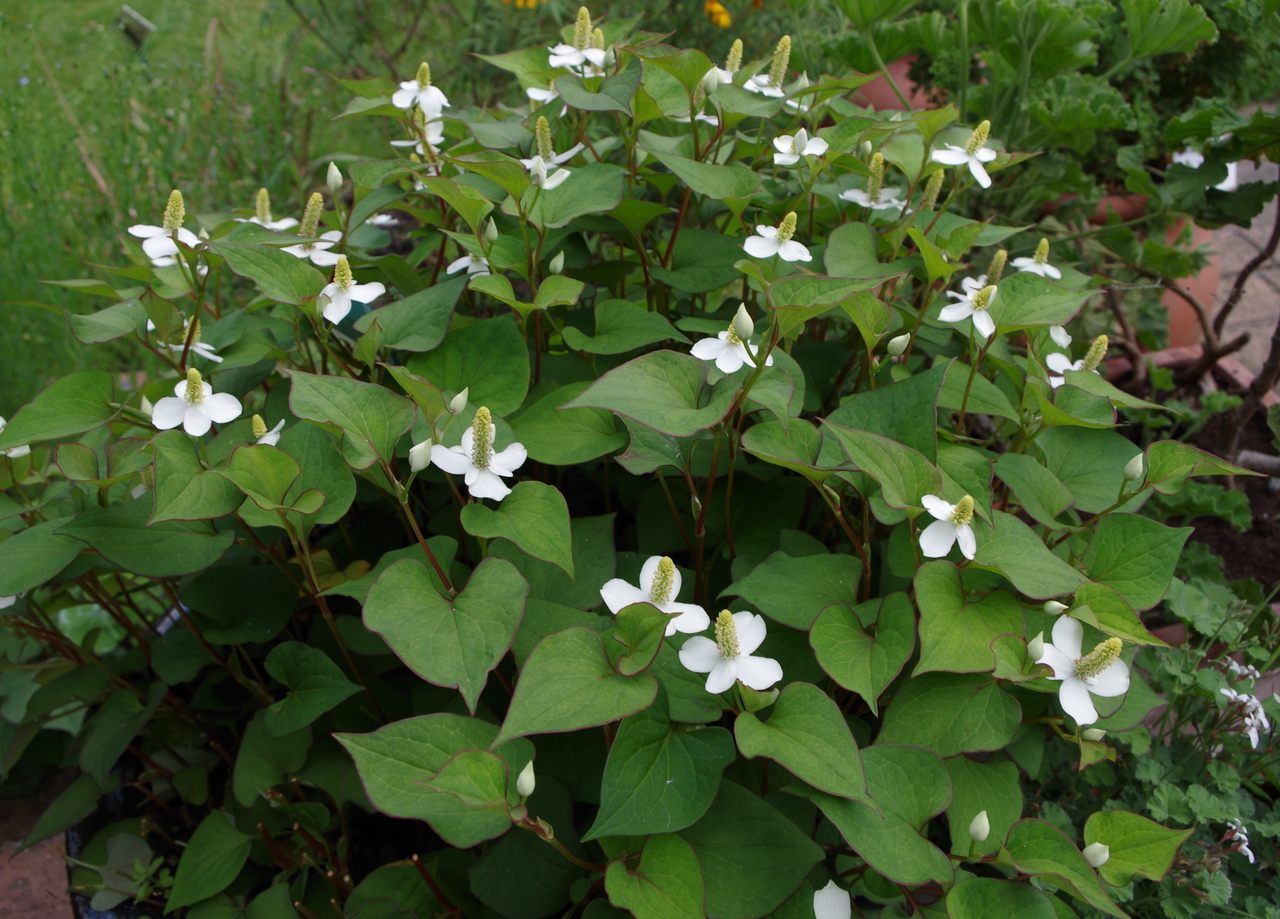Open Your Mind to This Polarizing Invasive Herb
Fish mint’s culinary applications are vast; which is good, because it’s taking over North America.
I’ve recently become obsessed with the species identification feature of iNaturalist and its sister app, Seek. It’s a great tool for learning to recognize local animals and plants whenever I find myself outdoors, and sometimes, the results are surprising: like when I pointed my phone at a low-lying plant with white flowers and deep green, heart-shaped leaves while walking through a park in New York City. I gasped in surprise when the app identified it as Houttuniya cordata: fish mint. “What’s an herb like you doing in a place like this?” I thought.
Up to that moment, I had only encountered fish mint once, when a Vietnamese friend shared some that he had grown in his garden. The distinctive musky scent and flavor of the leaves are derived from a volatile compound called decanoyl acetaldehyde. It’s often described as “fishy,” hence the plant’s English name. In Vietnam, cooks use fish mint to garnish soups and grilled meats, or add them to spring rolls and salads. But I had no idea that it could be found wild in the United States. How did a Southeast Asian herb end up growing in the Bronx?
For professional landscapers, fish mint’s dense foliage and low height make it desirable as ground cover; plant breeders have even developed ornamental varieties with appealing red or white leaves. But gardening websites warn of how easily fish mint can overtake any place where it is planted, due to its rapid growth and resistance to being uprooted. As the plant can regrow from just a fragment of its long rhizomes left in the soil, total eradication may take years, or even decades. A description from the Invasive Species Specialist Group makes fish mint sound like something out of Little Shop of Horrors: “There is much fear that it will eventually present a huge risk to native habitats … All uprooted plant material should be disposed of by incineration or taken to an official transfer station or landfill site.”

From its initial introduction to the United States as a decorative garden plant, fish mint has become an established invasive species, joining numerous others in altering habitats and seizing resources from native plants and animals. According to the U.S. Forest Service, invasive plants play a role in the decline of 42 percent of threatened native species in the United States, meaning we should all do our part to avoid spreading them. But when I realized the importance of curbing invasive fish mint, I had another idea besides tossing the plant in the incinerator: I harvested some leaves and rhizomes and started looking for recipes. (I also offered some to the friend who originally gave me fish mint, who told me he didn’t need it because “it grows like crazy.”)
“Eating the problem” of invasive species has long been touted as a solution to curbing the destructive spread of plants and animals in non-native environments. And if you want to eat an invasive species—a practice officially termed “invasivorism”—the best place to start is by looking at how people consume it in the place it came from. Luckily, when it comes to fish mint, there’s no shortage of possibilities.
Fish mint is often thought of in the United States as a Vietnamese herb, but the leaves and rhizomes are eaten regionally in many Asian countries, both cooked and raw. Avantika “Roohi” Haflongbar, a food vlogger from the state of Assam in northeast India, frequently uses the plant in her recipe videos. “I really like it. It has this minty flavor,” Haflongbar says in one video as she grinds fish mint leaves into chutney with onion and chili, which she serves as part of a thali platter with rice and aloo pitika, a mashed potato dish.

Food guide Jordan Porter described the prevalence of fish mint in some of China’s southern provinces in a 2016 VICE article by journalist Clarissa Wei: “In Guizhou, they chop up the roots into tiny pieces and use that as a condiment in all of their food. In Sichuan and Yunnan, the roots and leaves are made into salads.” A 2021 video by Yunnan-based food vlogger Dong Meihua, host of the YouTube channel Dianxi Xiaoge, showcases numerous local uses for the herb, from stir-fries and soups to iced water flavored with fish mint roots.
However, both Porter and Dong noted that even where the herb is native, its unique taste can be polarizing. “The number of people who are addicted to it almost equals the number of people who tried everything to stay away from it,” Dong noted in a video. While her videos usually feature her family enjoying the food she makes, one relative opted not to participate in her fish mint video due to their dislike for the ingredient. The plant’s long rhizomes have a milder flavor and fragrance that some might find more palatable than the leaves, reminiscent of cilantro or culantro. I enjoyed the ones I harvested in a raw salad based on a recipe from Dong’s video.
Fish mint is also used extensively in traditional medicine, and in some countries, such as Japan and Korea, medicinal use is more common than culinary. A review of the plant published by Frontiers in Pharmacology in 2021 noted that, in clinical studies, fish mint “has a significant inhibitory effect on virus infection and replication.” In the early 2000s, Chinese researchers cited fish mint as an effective antiviral against the coronavirus that caused the outbreak of SARS. This has led some researchers to theorize that the plant might be similarly effective against the coronavirus that causes COVID-19, although more study is necessary to confirm this.

Fish mint is far from the only invasive species with culinary and medicinal value. America’s forests, yards, and even cracks in the sidewalks are full of pungent garlic mustard, potatoey kudzu root, and delicate, herbal mugwort, which flavors sweet rice cakes in China and Korea. But convincing people to take advantage of this invasive bounty isn’t always easy. Part of the reason several introduced species of carp have spread throughout American waterways is that many people don’t want to eat them, believing that their bottom-feeding habits result in a muddy flavor. In 2022, Illinois state officials announced an official rebrand from carp to “copi” (because of their copi-ous numbers) to encourage more people to give the invasive fish a try. Perhaps fish mint could do with a more flattering English nickname.
In addition to the Chinese salad I made with the fish mint rhizomes, I also tried the leaves as a garnish for noodle soup, and in larb (Lao herb salad) with a mixture of other herbs, plus chili, lime, and toasted rice powder. A little fish mint goes a long way, and I find that it works best when balanced with raw onion or other powerful flavors.
Fish mint is often found in wet, shaded areas close to water; I found it growing next to a small stream. Next time you’re walking through the woods, keep an eye out for a low, leafy plant with heart-shaped leaves and an unmistakable scent. Fish mint is not for everybody. But if it’s invasive in your area, it’s worth considering adding to your diet.
Gastro Obscura covers the world’s most wondrous food and drink.
Sign up for our regular newsletter.































Follow us on Twitter to get the latest on the world's hidden wonders.
Like us on Facebook to get the latest on the world's hidden wonders.
Follow us on Twitter Like us on Facebook